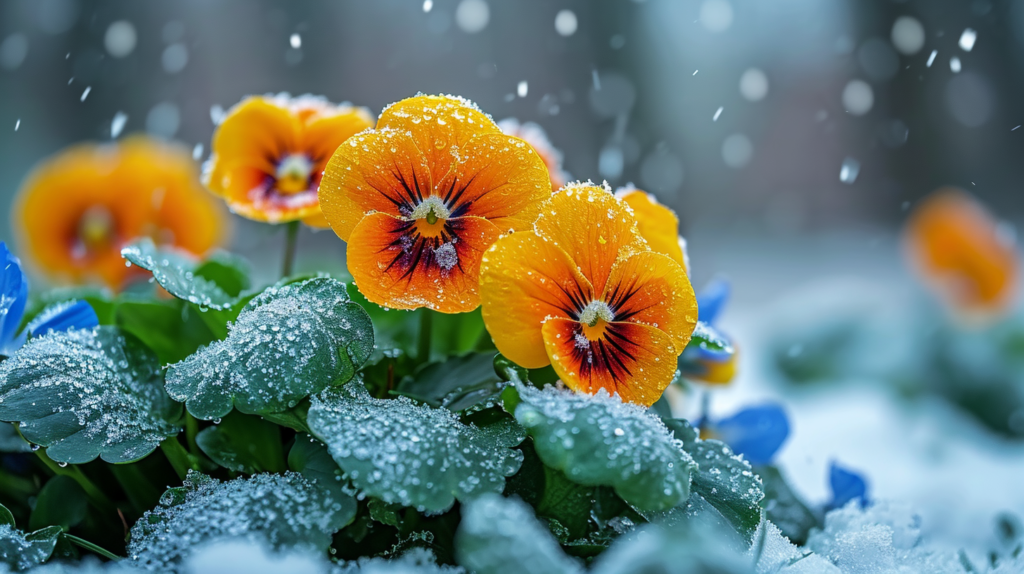Harsh winter weather can take a toll on lawns. Extended periods of cold temperatures, heavy snow, ice, and freeze-thaw cycles create prime conditions for fungal diseases. Left unchecked, lawn diseases that strike during winter months can damage turfgrass and leave unsightly patches in your yard. Implementing smart prevention and prompt treatment is key to keeping your lawn healthy through the dormant winter season.

Common Winter Lawn Diseases
Several lawn diseases are prevalent during cool, wet winters. Being able to identify the following common fungal diseases will help you effectively treat your lawn:
Snow Mold – Caused by fungus active in cool, wet conditions under snow cover or heavy leaf debris. Creates circular gray, matted patches up to several feet wide. Most common on bentgrass, annual bluegrass, and perennial ryegrass.
Pink Snow Mold – Identified by salmon-pink cobweb-like fungal growth in snow mold patches. Most prevalent when heavy snow comes before ground freezes. Affects all cool-season grasses.
Fusarium Patch – Causes yellow-brown patches up to several feet wide, often with pink or purple borders. Most active during cool, wet fall and winter. Affects all turfgrasses but particularly tall fescue.
Leaf Spot and Melting Out – Fungal leaf spot diseases create small, dark spots on grass blades that can merge into large dead patches. Most severe during cool, wet weather. Affects all lawn grasses.
Necrotic Ring Spot – Causes circular patches of yellowing, thinning turf up to several feet wide. Dark brown fungal rings may form in centers of patches. Affects mainly Kentucky bluegrass lawns.
Take steps to prevent diseases from occurring and regularly monitor your lawn for early symptoms.Prompt treatment is key to avoiding widespread lawn damage.
Lawn Care Practices to Prevent Winter Diseases
You can reduce the likelihood of winter lawn diseases by following smart cultural practices:
- Improve drainage across your yard and fill in any low spots. Standing water promotes fungal and bacterial growth. Install drainage pipes or French drains if needed.
- Maintain proper mowing height for your grass type going into winter. Never cut grass shorter than 2-3 inches or 1/3 of total blade length.
- Aerate compacted areas in early fall to improve water and air penetration to roots. Dethatch if thatch exceeds 1/2 inch depth.
- Apply preventative fungicide spray in mid-late fall after aerating or dethatching. Use targeted products for your grass type.
- Water early in the day to allow grass blades to dry out. Avoid excessive watering that keeps lawn continually wet.
- Remove leaves and debris promptly to prevent snow mold fungi from growing. Leaf blowers work well for clearing leaves.
- Test soil pH and adjust if needed. Most grasses grow best with slightly acidic pH of 6.0-6.5. Proper pH strengthens grass against diseases.
Treating Active Winter Lawn Diseases
If you spot lawn diseases, promptly treat affected areas:
- Rake or gently scrape out patchy areas to expose grass blades and remove matted debris. Allow sunlight to penetrate.
- Apply targeted fungicide if disease covers over 10% of the lawn. Use products labeled for snow mold, fusarium, or leaf spot as needed.
- Improve drainage and reduce irrigation to dry out diseased patches. Let soil dry between rainfalls or snow melts before watering again.
- Overseed treated areas with fresh grass seed once fungicide dries. Use same grass species as your existing lawn. Cover with straw to protect tender new seedlings.
- Top dress patches with 1/4 inch layer of compost to cover exposed turf and seed. Compost provides nutrients for recovery.
- Continue mowing at recommended height throughout winter if weather permits. Bag clippings to remove diseased debris.
- Reapply fungicide at label intervals if disease persists. Follow application guidelines carefully.
An ounce of prevention goes far when dealing with troublesome lawn diseases! Putting disease preventative practices in place along with prompt treatment will keep your lawn healthy even through harsh winter conditions.
Frequently Asked Questions About Winter Lawn Care
Q: What’s the best time to treat snow mold in lawns?
A: Treat snow mold as soon as symptoms appear, which is usually in early spring after snow cover recedes. Rake back affected areas then spray with targeted snow mold fungicide. Reseed if necessary once the fungicide dries.
Q: Should I fertilize my lawn in winter?
A: Avoid fertilizing cool-season grasses in winter when they are completely dormant. Fertilizing encourages growth that is vulnerable to cold damage. You can apply a light dose of slow-release fertilizer in very early spring before the grass greens up.
Q: How low can I mow my lawn in winter?
A: Only mow if the grass is still growing. For dormant grass, mow one last time to 2-3 inches before winter arrives. For active winter growth, mow no lower than 1/3 of the total blade length. Scalping dormant grass exposes it to more disease damage.
Q: Should I dethatch my lawn before winter?
A: Fall is an ideal time to dethatch cool-season lawns if thatch exceeds 1/2 inch depth. Thatch buildup blocks water, air, and nutrients from reaching roots. Just be sure to allow grass to recover for about four weeks before cold temperatures arrive.
Q: What causes brown patchy areas in my lawn over winter?
A: Brown patchy spots, especially with dark rings or margins, are typically caused by fungal diseases like fusarium patches and necrotic ring spots. Improve drainage and fertilize moderately to strengthen the grass. Treat promptly with appropriate fungicide if the disease is severe.
Q: How do I know if my lawn needs aerating before winter?
A: Signs your lawn needs aerating include obvious soil compaction, visible layers of thatch, standing water or poor drainage, and turf that feels spongy underfoot. Cool-season grasses benefit from fall aerating every 2-3 years. Leave plugs to decompose and nourish the soil.
With attentive lawn care and prompt treatment, if issues arise, your lawn can stay healthy and attractive all winter long. Protecting against common seasonal diseases will have your grass springing back beautifully once temperatures rise again.
